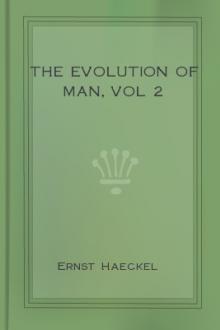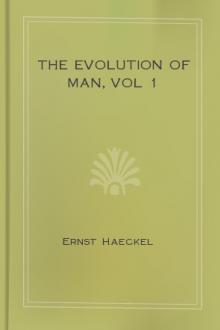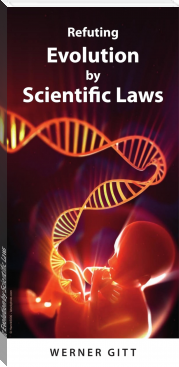The Evolution of Man, vol 2 by Ernst Haeckel (fun books to read for adults TXT) 📕

- Author: Ernst Haeckel
- Performer: -
Book online «The Evolution of Man, vol 2 by Ernst Haeckel (fun books to read for adults TXT) 📕». Author Ernst Haeckel
6 to 8. Coelenteria, without anus and body-cavity. : 8. Platodes II. Platodinia (with nephridia). : 8. Rhabdocoela. Vortex, Monotus.
9 to 11. Vermalia, with anus and body-cavity. : 9. Provermalia. (Primitive Worms.) Rotatoria. : 9. Gastrotricha. Trochozoa, Trochophora.
9 to 11. Vermalia, with anus and body-cavity. : 10. Frontonia. (Rhynchelminthes.) Snout-worms. : 10. Enteropneusta. Balanoglossus, Cephalodiscus.
9 to 11. Vermalia, with anus and body-cavity. : 11. Prochordonia. Chorda-worms. : 11. Copelata. Appendicaria. Chordula-larvae.
STAGES 12 TO 15. MONORHINA ANCESTORS.
Oldest vertebrates without jaws or pairs of limbs, single nose. : 12. Acrania I. (Prospondylia.) : 12. Amphioxus larva.
Oldest vertebrates without jaws or pairs of limbs, single nose. : 13. Acrania II. More recent. : 13. Leptocardia. Amphioxus.
Oldest vertebrates without jaws or pairs of limbs, single nose. : 14. Cyclostoma I. (Archicrania.) : 14. Petromyzonta larvae.
Oldest vertebrates without jaws or pairs of limbs, single nose. : 15. Cyclostoma II. More recent. : 15. Marsipobranchia. Petromyzonta.
B. MAN’S GENEALOGICAL TREE, SECOND HALF: LATER ANCESTORS, WITH FOSSIL EVIDENCE.
COLUMN 1 : GEOLOGICAL PERIODS. COLUMN 2 : ANCESTRAL STEM-GROUPS. COLUMN 3 : LIVING RELATIVES OF ANCESTORS.
Silurian. : 16. Selachii. Primitive fishes. Proselachii. : 16. Natidanides. Chlamydoselachius. Heptanchus.
Silurian. 17. Ganoides. Plated-fishes. Proganoides. : 17. Accipenserides. (Sturgeons.) Polypterus.
Devonian. : 18. Dipneusta. Paladipneusta. : 18. Neodipneusta. Ceratodus. Protopterus.
Carboniferous. : 19. Amphibia. Stegocephala. : 19. Phanerobranchia. Salamandrina. (Proteus, triton.)
Permian. : 20. Reptilia. Proreptilia. : 20. Rhynchocephalia. Primitive lizards. Hatteria.
Triassic. : 21. Monotrema. Promammalia. : 21. Ornithodelphia. Echidna. Ornithorhyncus.
Jurassic. : 22. Marsupalia. Prodidelphia. : 22. Didelphia. Didelphys. Perameles.
Cretaceous. : 23. Mallotheria. Prochoriata. : 23. Insectivora. Erinaceida. (Ictopsida +.)
Older Eocene. : 24. Lemuravida. Older lemurs. Dentition. 3. 1. 4. 3. : 24. Pachylemures. (Hyopsodus +), (Adapis +).
Neo-Eocene. : 25. Lemurogona. Later lemurs. Dentition. 2. 1. 4. 3. : 25. Autolemures. Eulemur. Stenops.
Oligocene. : 26. Dysmopitheca. Western apes. Dentition. 2. 1. 3. 3. : 26. Platyrrhinae. (Anthropops +), (Homunculus +).
Older Miocene. : 27. Cynopitheca. Dog-faced apes (tailed). : 27. Papiomorpha. Cynocephalus.
Neo-Miocene. : 28. Anthropoides. Man-like apes (tailless). : 28. Hylobatida. Hylobates. Satyrus.
Pliocene. : 29. Pithecanthropi. Ape-men (alali, speechless). : 29. Anthropitheca. Chimpanzee. Gorilla.
Pleistocene. : 30. Homines. Men, with speech. : 30. Weddahs. Australian negroes.
CHAPTER 2.21. OUR FISH-LIKE ANCESTORS.
Our task of detecting the extinct ancestors of our race among the vast numbers of animals known to us encounters very different difficulties in the various sections of man’s stem-history. These were very great in the series of our invertebrate ancestors; they are much slighter in the subsequent series of our vertebrate ancestors. Within the vertebrate stem there is, as we have already seen, so complete an agreement in structure and embryology that it is impossible to doubt their phylogenetic unity. In this case the evidence is much clearer and more abundant.
The characteristics that distinguish the Vertebrates as a whole from the Invertebrates have already been discussed in our description of the hypothetical Primitive Vertebrate (Chapter 1.11, Figure 1.98 to 1.102). The chief of these are: (1) The evolution of the primitive brain into a dorsal medullary tube; (2) the formation of the chorda between the medullary tube and the gut; (3) the division of the gut into branchial (gill) and hepatic (liver) gut; and (4) the internal articulation or metamerism. The first three features are shared by the Vertebrates with the ascidia-larvae and the Prochordonia; the fourth is peculiar to them. Thus the chief advantage in organisation by which the earliest Vertebrates took precedence of the unsegmented Chordonia consisted in the development of internal segmentation.
The whole vertebrate stem divides first into the two chief sections of Acrania and Craniota. The Amphioxus is the only surviving representative of the older and lower section, the Acrania (“skull-less”). All the other vertebrates belong to the second division, the Craniota (“skull-animals”). The Craniota descend directly from the Acrania, and these from the primitive Chordonia. The exhaustive study that we made of the comparative anatomy and ontogeny of the Ascidia and the Amphioxus has proved these relations for us. (See Chapters 2.16 and 2.17.) The Amphioxus, the lowest Vertebrate, and the Ascidia, the nearest related Invertebrate, descend from a common extinct stem-form, the Chordaea; and this must have had, substantially, the organisation of the chordula.
However, the Amphioxus is important not merely because it fills the deep gulf between the Invertebrates and Vertebrates, but also because it shows us to-day the typical vertebrate in all its simplicity. We owe to it the most important data that we proceed on in reconstructing the gradual historical development of the whole stem. All the Craniota descend from a common stem-form, and this was substantially identical in structure with the Amphioxus. This stem-form, the Primitive Vertebrate (Prospondylus, Figures 1.98 to 1.102), had the characteristics of the vertebrate as such, but not the important features that distinguish the Craniota from the Acrania. Though the Amphioxus has many peculiarities of structure and has much degenerated, and though it cannot be regarded as an unchanged descendant of the Primitive Vertebrate, it must have inherited from it the specific characters we enumerated above. We may not say that “Amphioxus is the ancestor of the Vertebrates”; but we can say: “Amphioxus is the nearest relation to the ancestor of all the animals we know.” Both belong to the same small family, or lowest class of the Vertebrates, that we call the Acrania. In our genealogical tree this group forms the twelfth stage, or the first stage among the vertebrate ancestors (Chapter 2.20). From this group of Acrania both the Amphioxus and the Craniota were evolved.
The vast division of the Craniota embraces all the Vertebrates known to us, with the exception of the Amphioxus. All of them have a head clearly differentiated from the trunk, and a skull enclosing a brain. The head has also three pairs of higher sense-organs (nose, eyes, and ears). The brain is very rudimentary at first, a mere bulbous enlargement of the fore end of the medullary tube. But it is soon divided by a number of transverse constrictions into, first three, then five successive cerebral vesicles. In this formation of the head, skull, and brain, with further development of the higher sense-organs, we have the advance that the Craniota made beyond their skull-less ancestors. Other organs also attained a higher development; they acquired a compact centralised heart with valves and a more advanced liver and kidneys, and made progress in other important respects.
We may divide the Craniota generally into Cyclostoma (“round-mouthed”) and Gnathostoma (“jaw-mouthed”). There are only a few groups of the former in existence now, but they are very interesting, because in their whole structure they stand midway between the Acrania and the Gnathostoma. They are much more advanced than the Acrania, much less so than the fishes, and thus form a very welcome connecting-link between the two groups. We may therefore consider them a special intermediate group, the fourteenth and fifteenth stages in the series of our ancestors.
(FIGURE 2.247. The large marine lamprey (Petromyzon marinus), much reduced. Behind the eye there is a row of seven gill-clefts visible on the left, in front the round suctorial mouth.)
The few surviving species of the Cyclostoma are divided into two orders—the Myxinoides and the Petromyzontes. The former, the hag-fishes, have a long, cylindrical, worm-like body. They were classed by Linne with the worms, and by later zoologists, with the fishes, or the amphibia, or the molluscs. They live in the sea, usually as parasites of fishes, into the skin of which they bore with their round suctorial mouths and their tongues, armed with horny teeth. They are sometimes found alive in the body cavity of fishes (such as the torsk or sturgeon); in these cases they have passed through the skin into the interior. The second order consists of the Petromyzontes or lampreys; the small river lamprey (Petromyzon fluviatilis) and the large marine lamprey (Petromyzon marinus, Figure 2.247). They also have a round suctorial mouth, with horny teeth inside it; by means of this they attach themselves by sucking to fishes, stones, and other objects (hence the name Petromyzon = stone-sucker). It seems that this habit was very widespread among the earlier Vertebrates; the larvae of many of the Ganoids and frogs have suctorial disks near the mouth.
The class that is formed of the Myxinoides and Petromyzontes is called the Cyclostoma (round-mouthed), because their mouth has a circular or semi-circular aperture. The jaws (upper and lower) that we find in all the higher Vertebrates are completely wanting in the Cyclostoma, as in the Amphioxus. Hence the other Vertebrates are collectively opposed to them as Gnathostoma (jaw-mouthed). The Cyclostoma might also be called Monorhina (single-nosed), because they have only a single nasal passage, while all the Gnathostoma have two nostrils (Amphirhina = double-nosed). But apart from these peculiarities the Cyclostoma differ more widely from the fishes in other special features of their structure than the fishes do from man. Hence they are obviously the last survivors of a very ancient class of Vertebrates, that was far from attaining the advanced organisation of the true fish. To mention only the chief points, the Cyclostoma show no trace of pairs of limbs. Their mucous skin is quite naked and smooth and devoid of scales. There is no bony skeleton. A very rudimentary skull is developed at the foremost end of their chorda. At this point a soft membranous (partly turning into cartilage), small skull-capsule is formed, and encloses the brain.
The brain of the Cyclostoma is merely a very small and comparatively insignificant swelling of the spinal marrow, a simple vesicle at first. It afterwards divides into five successive cerebral vesicles, like the brain of the Gnathostoma. These five primitive cerebral vesicles, that are found in the embryos of all the higher vertebrates from the fishes to man, and grow into very complex structures, remain at a very rudimentary stage in the Cyclostoma. The histological structure of the nerves is also less advanced than in the rest of the vertebrates. In these the auscultory organ always contains three circular canals, but in the lampreys there are only two, and in the hag-fishes only one. In most other respects the organisation of the Cyclostoma is much simpler—for instance, in the structure of the heart, circulation, and kidneys. We must especially note the absence of a very important organ that we find in the fishes, the floating-bladder, from which the lungs of the higher Vertebrates have been developed.
When we consider all these peculiarities in the structure of the Cyclostoma, we may formulate the following thesis: Two divergent lines proceeded from the earliest Craniota, or the primitive Craniota (Archicrania). One of these lines is preserved in a greatly modified condition: these are the Cyclostoma, a very backward and partly degenerate side-line. The other, the chief line of the Vertebrate stem, advanced straight to the fishes, and by fresh adaptations acquired a number of important improvements.
(FIGURE 2.248. Fossil Permian primitive fish (Pleuracanthus Dechenii), from the red sandstone of Saarbrucken. (From Doderlein.) I Skull and branchial skeleton: o eye-region, pq palatoquadratum, nd lower jaw, hm hyomandibular, hy tongue-bone, k gill-radii, kb gill-arches, z jaw-teeth, sz gullet-teeth, st neck-spine. II Vertebral column: ob upper arches, ub lower arches, hc intercentra, r ribs. III Single fins: d dorsal fin, c tail-fin (tail-end wanting), an anus-fin, ft supporter of fin-rays. IV Breast-fin: sg shoulder-zone, ax fin-axis, ss double lines of fin-rays, bs additional rays, sch plates. V Ventral fin: p pelvis, ax fin-axis, ss single row of fin-rays, bs additional rays, sch scales, cop penis.
FIGURE 2.249. Embryo of a shark (Scymnus lichia), seen from the ventral side, v breast-fins (in front five pairs of gill-clefts), h belly-fins, a anus, s tail-fin, k external gill-tuft, d yelk-sac (removed for most part), g eye, n nose, m mouth-cleft.)
The Cyclostoma are almost always classified by zoologists among the fishes; but the incorrectness of this may be judged





Comments (0)